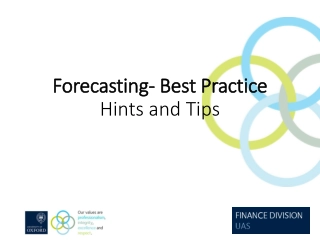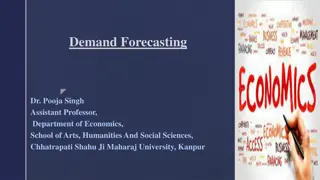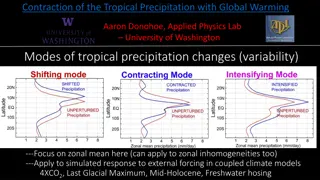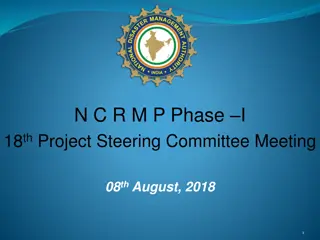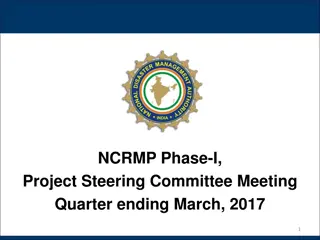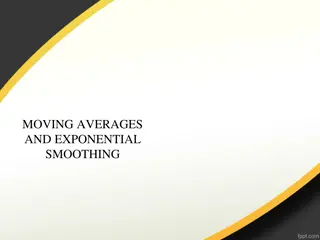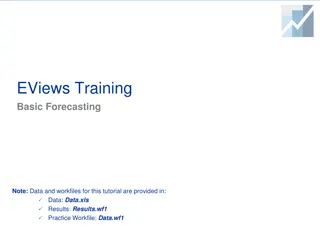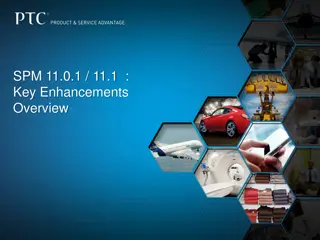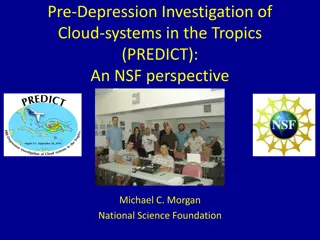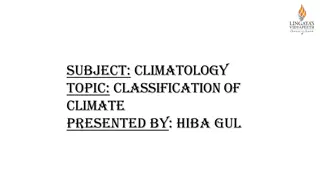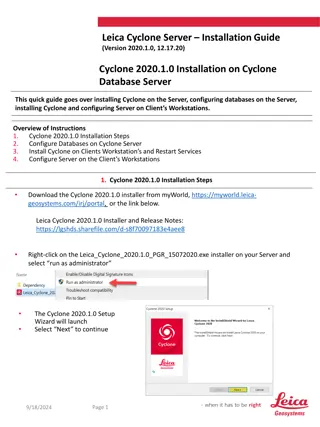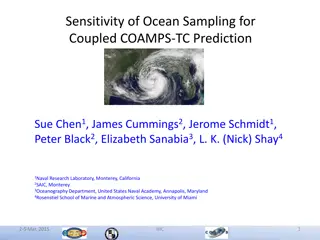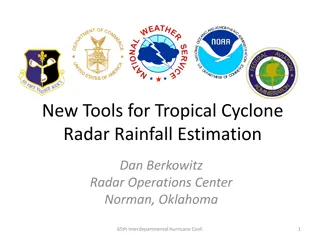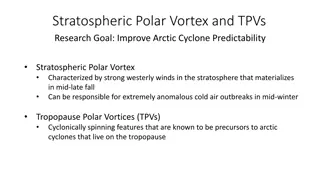Enhancements to COAMPS Tropical Cyclone Forecasting Methods
This presentation discusses the application of new methodologies in COAMPS for improving tropical cyclone forecasting. It covers synthetic TC observations, analysis with NAVDAS, and the real-time run methodology for generating initial fields in the model. The incorporation of observations and TC synthetics enhances the accuracy of forecasts, demonstrating advancements in storm prediction techniques.
Download Presentation

Please find below an Image/Link to download the presentation.
The content on the website is provided AS IS for your information and personal use only. It may not be sold, licensed, or shared on other websites without obtaining consent from the author. Download presentation by click this link. If you encounter any issues during the download, it is possible that the publisher has removed the file from their server.
E N D
Presentation Transcript
Application and Improvements to Application and Improvements to COAMPS COAMPS- -TC TC Richard M. Hodur1, J. Doyle2, E. Hendricks2, Y. Jin2, J. Moskaitis2, K. Sashegyi2, J. Schmidt2 1Innovative Employee Solutions/Science Applications International Corporation, Monterey, CA 2Naval Research Laboratory, Monterey, CA 2013 IHC/Tropical Cyclone Research Forum College Park, MD 4-8 March 2013
Application and Improvements to Application and Improvements to COAMPS COAMPS- -TC Outline TC Current Methodology Synthetic Observations Real-Time Run Methodology Proposed New Methodology New Synthetics Dynamic Initialization Conclusion and Future Plans
Synthetic TC Observations Purpose Create observations of the TC circulation, making up for the lack of real-time in- situ observations Current Methodology Current Methodology Fixed radii @ 0.5 , 1 , 2 , 3 , 4 , and 6 8 profiles per radial ring u-, v-, T, z values at each point Modified Rankine vortex 9 levels from 1000 to 400 mb Fixed vertical profile/No vertical tilt Current storm motion included Large-scale shear added TC Synthetics for Ernesto 2012
TC Analysis with NAVDAS Sandy: 2012102500 Analysis Relocate TC/Grid Assimilate TC synthetics and all other real-time observations First-Guess Field Final Analysis NAVDAS: NRL Atmospheric Variational Data Assimilation System
COAMPS Real-Time Run Methodology Performed in 2008-2009 @ AF DSRC, 2010-2013 @ Navy DSRC Cold Start Global Analyses Observations and TC Synthetics are used together in NAVDAS to generate the initial fields for the model Observations NAVDAS TC Synthetics Warm Start 6-h Forecast Fields A 2-d ocean SST analysis (NCODA) is used to produce the SST field that is held constant during each forecast 120-h Forecast SST Analysis Global Forecast Fields - LBC
COAMPS Real-Time Run Methodology Performed in 2008-2009 @ AF DSRC, 2010-2013 @ Navy DSRC Cold Start Global Analyses The first time the system is run for a TC, a cold start is done, so global fields are used for the first-guess fields and for the lateral boundary conditions Observations NAVDAS TC Synthetics 120-h Forecast SST Analysis Global Forecast Fields - LBC
COAMPS Real-Time Run Methodology Warm Start After the first time that COAMPS-TC is run for a system, warm starts are done and the global model fields are used only to supply the lateral boundary conditions Observations NAVDAS TC Synthetics Warm Start 6-h Forecast Fields 120-h Forecast SST Analysis Global Forecast Fields - LBC
COAMPS-TC Areas Western North Pacific: 281x151 Western North Atlantic: 281x151 Central and East North Pacific: 321x151 Arabian Sea and Bay of Bengal: 281x151 Triple nested grids: 45/15/5 km Inner grids: Move with the TC 121x121 (15 km), 181x181 (5 km) Multiple storms in any basin are run separately SW Pacific and South Indian Ocean: 521x151
Synthetic TC Observations: New Purpose Create a new set of observations of the TC circulation that can be adapted for different sized storms Proposed New Methodology Proposed New Methodology Variable positioning of the radial rings: One ring for the RMW (observed or first-guess) User-defined density (# of rings, # of synthetics per ring, and ring spacing) User-defined radii of outer-ring Any number of profiles per radial ring u-, v-, T, z values Modified Rankine vortex 7 levels from 1000 to 400 mb Fixed vertical profile/No vertical tilt Current storm motion included Large-scale shear added TC Synthetics for Ernesto 05L/2012 TC Synthetics for invest area 98W/2013
Pre-Retro Test Cases 99 Cases from 2010, 2011, and 2012 TC Name Start End # of cases 07L 11L 09L 12L 14L 17L 05L 09L 18L 19L Earl Igor Irene Katia Maria Philippe Ernesto Isaac Sandy Tony 2010082600 2010091012 2011082212 2011083000 2011090700 2011092812 2012080200 2012082112 2012102300 2012102300 2010090112 2010091512 2011082512 2011090512 2011091212 2011100312 2012080500 2012082600 2012102700 2012102412 14 11 7 14 12 11 7 10 9 4
COAMPS-TC Track Forecasts Old vs. New TC Synthetics Ernesto (2012/05L) Old Synthetics New Synthetics The new synthetics led to improved track forecasts for Ernesto, particularly in it s early stages
COAMPS-TC Track Forecasts Old vs. New TC Synthetics Katia (2011/12L) Old Synthetics New Synthetics The new synthetics led to improved track forecasts for Katia, particularly during recurvature
Effect of Synthetic Observations on COAMPS-TC Track Forecast Errors Old ( control , blue) vs. New ( b , green) TC Synthetics The average track error over all storms was lower using the new synthetics for all forecast times.
Effect of Synthetic Observations on COAMPS-TC Intensity Forecast Errors Old ( control , blue) vs. New ( b , green) TC Synthetics The average intensity error over all storms was lower using the new synthetics during the 30- 102 h time period. Initial spin-down
COAMPS Real-Time Run Methodology Performed in 2008-2009 @ AF DSRC, 2010-2013 @ Navy DSRC Cold Start Global Analyses Reminder This is the method that is currently used for running COAMPS-TC Observations NAVDAS TC Synthetics Warm Start 6-h Forecast Fields 120-h Forecast SST Analysis Global Forecast Fields - LBC
COAMPS Proposed Run Methodology TCDI/DI: Tropical Cyclone Dynamic Initialization/Dynamic Initialization Hendricks et al. (2011) WAF, Zhang et al. (2012) WAF, Hendricks et al. (2013) MWR, submitted Cold Start Global Analyses Observations NAVDAS Warm Start 6-h Forecast Fields Remove TC Vortex TCDI Insert TC Vortex ?? ??= ?(? ??) 120-h Forecast 12-h DI Forecast DI SST Analysis Global Forecast Fields - LBC
Effect of TCDI/DI on COAMPS-TC Track Forecast Errors Old ( control , blue) vs. TCDI/DI ( c , green) The average track error over all storms was unchanged using the TCDI/DI methodology for all forecast times.
Effect of TCDI/DI on COAMPS-TC Intensity Forecast Errors Old ( control , blue) vs. TCDI/DI ( c , green) The average intensity error over all storms was lower using TCDI/DI during the 6-54 h time period. Also, the initial spin-down was eliminated.
COAMPS Proposed Run Methodology NS/DI: New Synthetics/Dynamic Initialization Cold Start Global Analyses Observations NAVDAS New TC Synthetics ?? ??= ?(? ??) 12-h DI Forecast Warm Start 6-h Forecast Fields 120-h Forecast SST Analysis Global Forecast Fields - LBC
Conclusion and Future Plans COAMPS-TC Real-time applications (2008-2012) New synthetics: Improved track forecasts Improved intensity forecasts TCDI/DI: No change to track forecasts Improved intensity forecasts Eliminates initial spin-down Next steps: New synthetics DI 2013 retro cases and real-time forecasts
Application and Improvements to Application and Improvements to COAMPS COAMPS- -TC TC Richard M. Hodur1, J. Doyle2, E. Hendricks2, Y. Jin2, J. Moskaitis2, K. Sashegyi2, J. Schmidt2 1Innovative Employee Solutions/Science Applications International Corporation, Monterey, CA 2Naval Research Laboratory, Monterey, CA 2013 IHC/Tropical Cyclone Research Forum College Park, MD 4-8 March 2013





